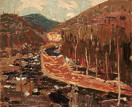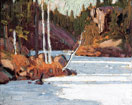Tom Thomson at Achray in 1916, Conclusions
If you're looking for Tom Thomson sketching locations from 1916, look close to Achray.
Tom Thomson spent the summer of 1916 working as a fire ranger out of Achray on Grand Lake in Algonquin Park. Two events of that sumer are often mentioned: In his role as a fire ranger, he followed the Booth Lumber Company's drives down the Petawawa River at the north end of the Park and in August, with his fire-ranger partner, Ed Godin, he undertook a canoe trip down the South Branch of the Petawawa (now the Barron) River and up the North Branch to Lake Traverse (now Lake Travers).
However, the vast majority of his output in the season of 1916 is not associated with these two trips.
In the spring of 1917, in a letter to Tom Harkness (his brother-in-law), Thomson, stated: I have not applied for the fire rangers job this year as it interferes with sketching to the point of stopping it altogether so in my case it does not pay.
The previous fall in a letter to Dr. MacCallum (his patron) he wrote: Have done very little sketching this summer as the two jobs don't fit in. ... When we are travelling two go together, one for canoe and the other the pack. And there's no place for a sketch outfit when you're fire ranging.
The implication is that most of Thomson's sketches of 1916 were done on Thomson's down time at Achray, not when he was out fire ranging. And based on sketch locations we have identified, this seems to be the case.
One might expect that these comments would also apply to his trip with Ed Godin up to Lake Travers via the south and north branches of the Petawawa River, that is ... one for canoe and the other the pack. And there's no place for a sketch outfit ...
But Ed Godin is quoted as saying that he remembers Thomson sketching The Capes (Barron Canyon) on that trip. With two exceptions (Petawawa, Algonquin Park and Petawawa Gorges, Night), there are no sketches of identifiable locations on the Barron River downstream of the Barron Canyon or anywhere on the (North Branch of the) Petawawa River in spite of the impressive, wild, and distinctive scenery along those two river sections.
The Barron Canyon sketches may have been painted on this trip or at some other time. We know that this trip was not Thomson's only visit to the canyon. In a note to J.E.H. MacDonald in 1916 June he wrote: This is a great place for sketching, one part of the river (South Branch Petawawa) runs between walls of rock about 300 feet straight up. Will camp there when this fire job is finished.
The colour and lighting of his Barron Canyon sketches are consistent with having been painted in early October, that is when this fire job is finished
.
The situation with respect to sketching the log drive is not clear. If Thomson actually did follow the Booth log drive, it is almost certain that it was down the Barron River not (the north branch of) the Petawawa River. Or maybe it was on Carcajou Creek. But it seems unlikely that Thomson would have had his sketching gear with him. Perhaps Thomson simply interacted with the log drive as it passed through Grand Lake and environs. This is consistent with the reminiscences of Pete Sauvé of the Booth Lumber Company. We also know that Ed Godin and Tom Thomson would occasionally board at lumber camps which would have been dotted throughout the area. Pete Sauvé stated that the lumbermen thought Thomson and his painting were foolish but we don't know if this impression was gained at Grand Lake or farther afield.
We are left to conclude that the vast majority of Thomson's sketches in the summer of 1916 were painted on his down time when he was not out fire ranging. This is what he said and that is what we have found; most of the identifiable sketching locations are very close to Achray. Several appear to have been painted right from the front porch of the Out-Side-In (or perhaps from the beach out front). Of the locations we have identified, only a few are farther away than an hour's travel time from Achray. The locations along the portage between St. Andrews Lake and High Falls Lake are two to three hours distant. Only the sketching locations in the Barron Canyon, at Tarn Lake and the site of the Log Jam would likely require an overnight trip — and of course, The Natch.
There are several sketches from 1916 that should be readily findable that leave us stumped. These include: Timber Chute, Bateaux, Algonquin Park, and others.
Joan Murray's Tom Thomson Chronology for 1916 has Thomson visiting Huntsville in early March, then sketching and fishing with Lawren Harris, Lawren's cousin Chester Harris and Dr. MacCallum at (Little) Cauchon Lake in late April/early May, and starting his fire ranging job in late May. We suspect that for at least some of the time between mid March and late April, Thomson was at Achray. This belief is based on identifying at least two sketches, The Last Snow, Algonquin Park and In Petawawa Gorges, Spring, that we believe are from the Achray area before ice-out. An inscription on the back of the latter sketch, ascribed to MacCallum said Ice still present toward middle of April. Painted near mouth of Petawawa from Achray, Grand Lake
. This might suggest that MacCallum was present. Perhaps MacCallum and Thomson travelled to Cauchon Lake together by train via Achray.
We are uncertain of Thomson's whereabouts after leaving Cauchon Lake in early May and moving in to the Out-Side-In in early June. But we note that Ed Godin did not say that Thomson started his fire ranging job in early June, only that Thomson moved into the Out-Side-In in early June. So he may well have been at Achray during this period.
We have made some progress in identifying sketching locations in the Cauchon Lake area but we need more and better photos; perhaps we will add those sketches at a later date
Notes
Dr. James MacCallum was a wealthy Toronto doctor and art investor. He was Tom Thomson's patron.
The complete text of the two quoted letters (and others) are reproduced in Tom Thomson's Letters, compiled by Joan Murray, in the book Tom Thomson (Dennis Reid, editor; Douglas and McIntyre; 2002;). See also Death on a Painted Lake: Letters.
Pete Sauvé was a cook with on the J.R. Booth log drive that passed through Grand lake in 1916, where he met Tom Thomson. His reminiscences were recorded in 1970 (50+ years after the fact) and are quoted in part by Andrew Hunter in his essay Mapping Tom in the book Tom Thomson (Dennis Reid, editor; Douglas and McIntyre; 2002; page 32). One might gather from Sauvé's comments that the sketch Log Jam was painted at the dam at the foot of Grand Lake. Others believe this as well but the background hills don't match. However, that location is consistent with the thesis that Thomson didn't paint at all when on the job.
In concluding that most of Tom Thomson's painting from the sumer of 1916 are from very close to Achray, we are mindful of the old saw about the drunk searching for his car keys under a streetlight:
"What are you doing?"
"Searching for my car keys"
"Oh, did you drop them here?"
"No, I dropped them at the other other end of the street."
"Well, why are you searching here?"
"The light's much better here."
We are reasonably sure that we're not making the same mistake.
In 1916, the Achray area was no doubt rugged and remote. But it was not pristine wilderness. For the previous 50 years it had been extensively logged. In the late 1800s, massive fires ravaged the general area and adjacent Ottawa Valley. The forest cover of 1916 would have been largely new growth with little, if any of the original pine.
This area was added to Algonquin Park in 1914, about the time the railway came to Achray (1912-1915). However, because of the extensive logging history of the area, there would have been a network of trails and winter roads and scattered lumber camps. A knowledge of some of these roads has survived, but most have been lost to the forest. A better appreciation of the communication routes of the time would help with identifying potential sketching locations.
In his book A Few Rustic Huts S.R. Gage describes, (without attribution) the role of (fire) rangers:
For many years the rangers' work centred around two primary tasks - watching for fires and apprehending poachers. In 1922 fire ranging was made a separate responsibility under the direction of a district forester. In 1931 the two jobs were re-combined under a plan administered by a new Park superintendent, Frank A. MacDougall.
Gage further quotes from Superintendent George Bartlett's annual report of 1919:
In general, two rangers travel together, having a stated section to look after in which they keep the portages cut out and the shelter houses in order. These shelters are usually a day's journey apart, and the practice is for the ranger to spend several days at each looking over adjacent territory.
The area around Achray was added to Algonquin Park in 1914. Thus it seems likely that in 1916, the local network of shelter huts was probably still only being developed.
Sources
S.R. Gage. 1985. A Few Rustic Huts, Mosaic Press, Oakville.
Dennis Reid, ed. 2002. Tom Thomson, Douglas & McIntyre, Vancouver/Toronto.









